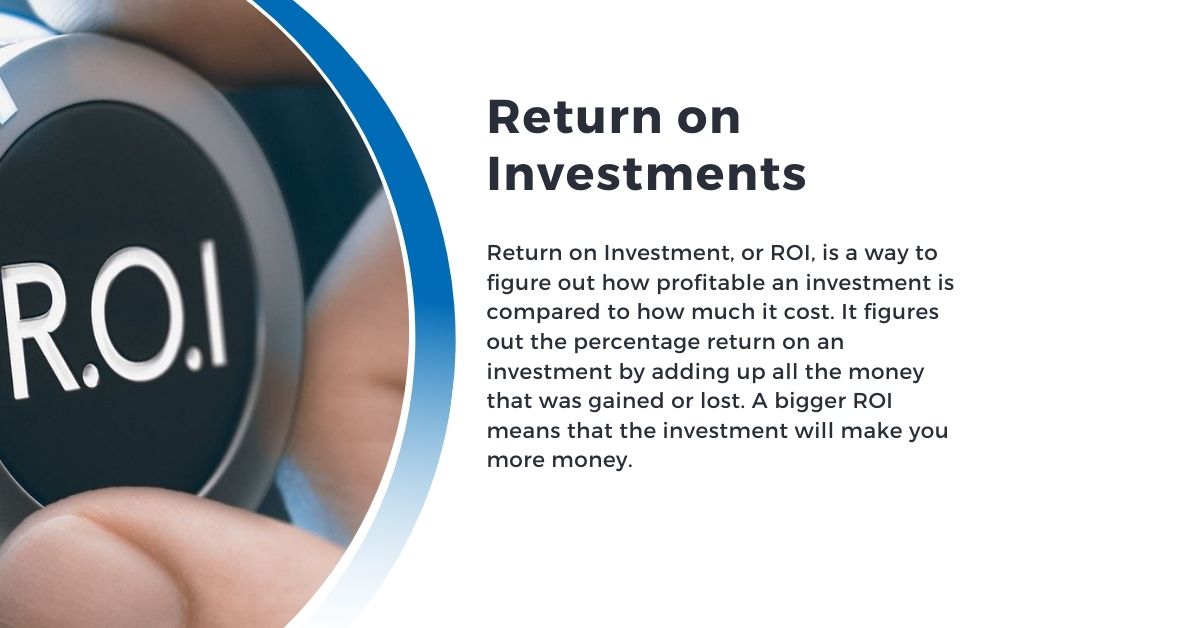Return on investment, or ROI, is a way to figure out how profitable a purchase is. ROI figures out how useful an investment was by comparing how much you spent on it to how much you made from it. Let’s look at how companies and individual investors use it.
What is Return on Investments?

Return on Investment, or ROI, is a way to figure out how profitable an investment is compared to how much it cost. It figures out the percentage return on an investment by adding up all the money that was gained or lost. A bigger ROI means that the investment will make you more money.
How to Calculate Return on Investment?
The following method is used to figure out Return on Investment (ROI):
ROI = [(Net Profit or Loss / Initial Investment) * 100]
- Net Profit or Loss: This is the difference between the investment’s final value and its initial cost.
- Initial Investment: This is the original amount invested.
For example, if you invest ₹10,000 and sell the investment for ₹12,000, your net profit would be ₹2,000. Your ROI would then be:
ROI = [(₹2,000 / ₹10,000) * 100] = 20%
This means that for every ₹1 you invested, you earned a return of ₹0.20 or 20%.
How Do Returns on Investments Work?
Returns on investments, or ROI, show how much money an investment made or lost compared to how much it cost to make in the first place. These returns can look like different things, such as:
- Capital gains happen when an investment’s value goes up over time and it is sold for a profit.
- Dividends are regular payments that companies make to the people who own shares in them.
- This is the money that you get from investments that are based on debt, like bonds.
- Rent: This is the money that real estate purchases bring in.
When you buy, you want to get a return that is higher than the rate of inflation. This way, your money will grow in value over time. The exact returns on an investment rely on a number of things, such as the type of investment, the state of the market, and the investor’s willingness to take risks.
If you want to know about return on assets, you can read this article What is Return on Assets (ROA)?
How to Use ROI?
ROI is a flexible tool that people and businesses use to judge how well investments are doing. It helps you figure out which investments will make you money and compare their returns. ROI helps investors decide if an investment is worth the risk and helps them make smart choices about their businesses.
ROI is a way for businesses to figure out how well their marketing efforts, projects, or new products are doing. By figuring out ROI, businesses can see which projects are bringing in the most money and then focus their efforts on those. If you want to see how well different business investments, like capital spending or research and development projects, are doing, you can also use ROI.
What Are Examples of ROI Calculations?
Here are some examples of how to figure out ROI:
- Buy a stock for ₹100 and sell it for ₹120 a year later. You will have made a net profit of ₹20. ROI for you would be 20%, which is (20% of 100) times 100.
- In the real estate investment world, if you buy a house for ₹5,000,000 and rent it out for ₹30,000 a month, you will make ₹360,000. If you sell the house for ₹6,000,000 after five years, you will have made ₹360,000 (annual rent). * 5 years + ₹1,000,000 (selling price – buying price) = ₹3,000,000. It would be (₹3,000,000 / ₹5,000,000). * 100 = 60%.
- Marketing Campaign: If a business spends ₹100,000 on a marketing campaign that brings in an extra ₹250,000 in sales, it makes a net profit of ₹150,000. The campaign’s return on investment would be ₹150,000 divided by ₹100,000. * 100 = 150%
Benifits and Risk of ROI
| Benefit | Risk |
|---|---|
| Clear and easy to understand: ROI provides a straightforward measure of profitability. | Doesn’t consider time value of money: ROI doesn’t account for the fact that money earned today is worth more than money earned in the future. |
| Can be used to compare different investments: ROI allows for a direct comparison of the profitability of various investment options. | Can be influenced by accounting methods: Different accounting methods can affect ROI calculations, potentially leading to inaccurate comparisons. |
| Helps identify successful investments: A high ROI indicates a profitable investment. | Doesn’t account for risk: ROI doesn’t consider the level of risk associated with an investment. |
| Can be used to evaluate business performance: ROI can be used to assess the efficiency of business operations and marketing campaigns. | Can be misleading for long-term investments: ROI can be misleading for long-term investments that have a high initial cost but generate significant returns over time. |
What Is a Good ROI?
What is a “good” ROI depends on the investment and how risky the owner is willing to be. A return on investment (ROI) of 5% or more is usually thought to be good, especially when inflation is taken into account. But the estimated return on investment (ROI) for different investments can be very different. One example is that stocks and real estate assets often have higher possible returns than bonds or savings accounts. However, they also carry higher risks.
It’s important to look at the danger and return on an investment side by side. For a riskier investment, a higher ROI might be fine, while for a safer investment, a smaller ROI might be enough. When deciding if a ROI is right for them, investors should also think about their own financial goals and time span.

